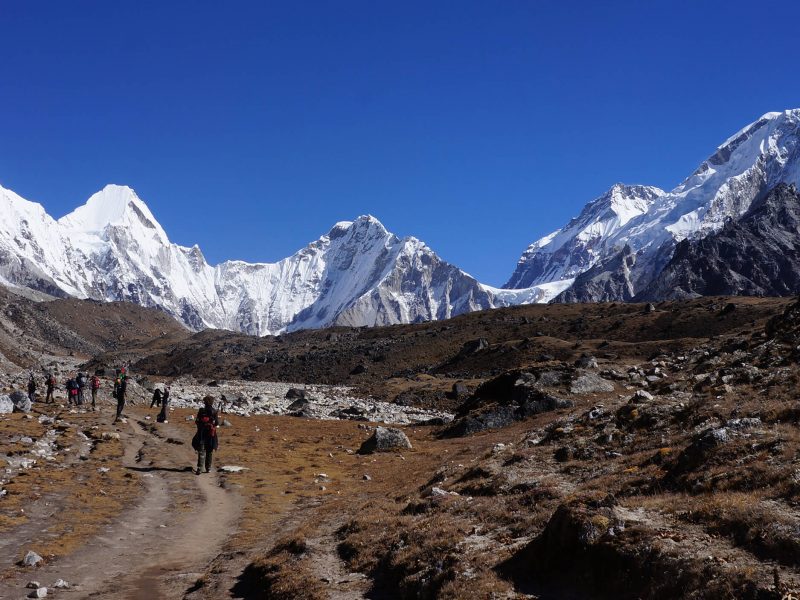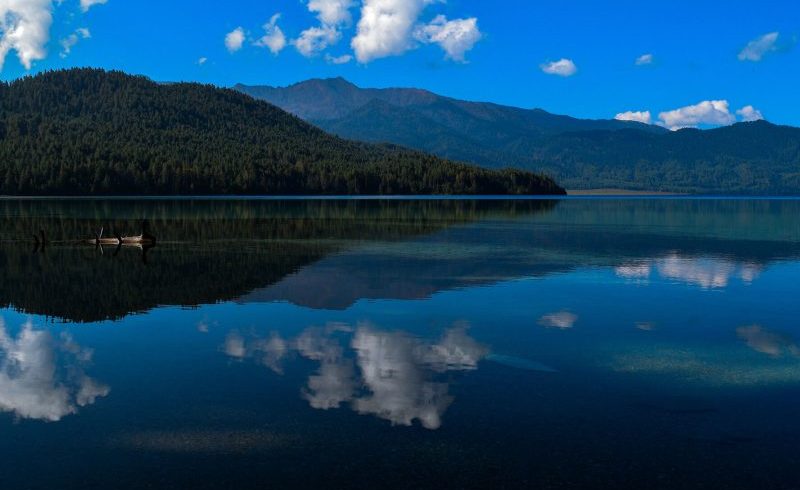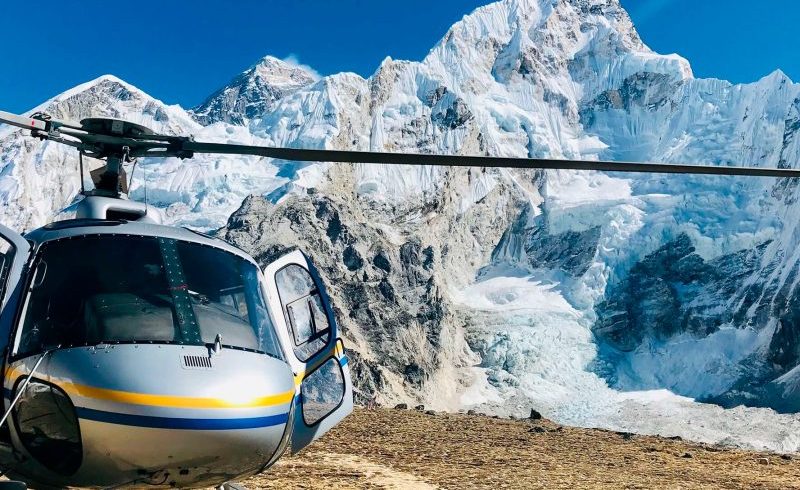The Everest Base Camp Helicopter Trek caters to adventurers seeking the ultimate Himalayan experience in a condensed timeframe. This meticulously crafted itinerary seamlessly blends the classic Everest Base Camp trek with a thrilling helicopter expedition, offering a glimpse into the magic of the world’s highest mountain.
Time Crunch, Not Adventure:
Imagine standing at the foot of Mount Everest, the Earth’s crown jewel, within a week. This trek caters to those with limited time who still yearn for the thrill of an Everest expedition. Gone are the days of dedicating weeks to reach the base camp; this helicopter-assisted trek allows you to experience the majesty of the Himalayas efficiently.
A Scenic Helicopter Voyage:
The adventure begins with a captivating helicopter flight from the bustling capital, Kathmandu, to Lukla, the gateway to Everest region. As you soar through the air, witness the dramatic transformation of the landscape, transitioning from the urban sprawl to the captivating tapestry of the Himalayas.
A Journey Through Lush Valleys and Vibrant Culture:
Lukla serves as the starting point for your trek. Prepare to be enchanted by the picturesque Dudh Koshi Valley, adorned with lush pine forests, vibrant rhododendrons, and cascading waterfalls. The trail winds its way past traditional Sherpa villages, their colorful houses adorned with prayer flags fluttering in the breeze. Crossing rickety suspension bridges adorned with vibrant prayer flags adds a touch of adventure to the initial leg.
Everest Base Camp: A Dream Realized:
The heart of the trek lies in reaching Everest Base Camp (EBC). Standing amidst the colossal peaks of the Khumbu region, with the mighty Everest towering above, is an experience that ignites a sense of awe. Witness the awe-inspiring Khumbu Glacier, a massive river of ice snaking through the heart of the Himalayas, further adding to the profoundness of the location.
Kala Patthar: A Breathtaking Panorama:
The trek doesn’t stop at EBC. For those seeking an extra dose of adventure, a challenging yet rewarding hike to Kala Patthar awaits. This vantage point, perched at an elevation of 5,364 meters, offers a panoramic vista unlike any other. Witness a dazzling array of peaks, including Everest, Lhotse, Nuptse, and countless others exceeding 7,000 meters, their snow-capped summits glistening under the sun.
A Helicopter Ascent: A Once-in-a-Lifetime Experience:
After basking the glory of Himalayas from the ground, it’s time to experience their grandeur from a whole new perspective. Board a helicopter for a thrilling ride back to Lukla. Soar above the dramatic landscape, witnessing the interplay of deep valleys, cascading glaciers, and the iconic peaks that have captivated explorers for centuries. This aerial voyage provides an unparalleled opportunity to truly grasp the scale and majesty of the Everest region.
Conclusion:
Everest Base Camp adventure culminates with a helicopter flight back to Kathmandu, bringing you back to the bustling capital city. This unique blend of trekking and helicopter travel allows you to experience the magic of the Everest region in a shorter timeframe, leaving behind an indelible memory of breathtaking scenery, cultural immersion, and a touch of exhilarating adventure.
Everest Base Camp Helicopter Trek is perfect trekking, for all adventure lovers. Be a part of this thrilling experience with your travel partner Female Guide Kathmandu.
Itinerary
With a panoramic view of the Himalayan ranges and the valley below, the flight into Kathmandu Valley is wonderful. Our representative will greet you at the Tribhuvan International Airport, drive you to your accommodation, and assist you with all of your essential travel needs. After you've checked in, you'll have time to tour the city (depending on your arrival time).
Board a helicopter from Tribhuvan International Airport and start your incredible Everest Base Camp adventure. As you hover over the mountains, glance down to see the Himalayan range's rugged peaks. It's a flight to remember, with breathtaking vistas of valley, hilltop towns, and towering Himalayan peaks. Till you reach Lukla, once you reach Lukla you'll be meeting with our representative at the airport, grab your belongings and hike to Phakding through the bustling Lukla market. Phakding, a riverfront village, is accessible by crossing a metal suspension bridge. Later, take a walk around the village and down to the riverbank to admire the Dudh Koshi, a glacier river that cascades down the valley. Later, return to the lodge and rest.
The trail passes through pine and rhododendron woodland, roaring glacier rivers, metal suspension bridges, you'll be crossing the iconic Hillary Bridge, the tallest suspension bridge in the Everest area. As you move upwards, you'll be encircled on all sides by massive mountain peaks. High summits peaks stretch towards the sky, as you arrive at Namche, a beautiful route with Mani stones, Buddhist monasteries, and vibrant prayer flags, and the mountains spread out like an amphitheater. From here, you can get the first glimpse of Mount Everest (8,848m), Lhotse (8,516m), and other peaks. Namche, commonly known as the Sherpa capital, has a variety of high-end and low-cost mountain lodges, after you get to your accommodation rest your weary limbs.
You'll be spending your day acclimatizing at Namche. The village is the economic core of the Khumbu area, featuring cafés, bakeries, mountain lodges, shops, and internet cafes. Take a stroll around the marketplace, talk to some friendly locals and soak in the mountains. Visit the nearby Sherpa village Khumjung or trek to the famous Hotel Everest View of Khumjung, as an acclimatization excursion. Ama Dablam, Tawache, Khumbu Himal, Mount Everest, and many more peaks can be seen from the hotel's terrace or you may hike up to Khumbu school which was established by Sir Edmund Hillary the first school in the Khumbu area in Khumjung. A visit to the historic Khumjung Monastery, which houses a Yeti (abominable snowman) scalp, is also recommended. Hike back to Namche afterward where you'll spend the night.
You'll be hiking along with one of the most exquisite sections of the trail today, cross an alpine meadow with pine trees and rhododendron blossoms on your way to Tengboche, take a break every now and then to take in the spectacular mountain scenery. Tengboche is just under Ama Dablam centered by the magnificent Tengboche Monastery which is one of the Everest Region's oldest and most prominent Buddhist monasteries, inside the monastery, old artifacts are displayed at the altar, and colorful Buddhist artwork covers the walls, observe the monks chanting the sacred texts. Later, walk down to Deboche, a monastic settlement where you'll spend the night.
Get up early in the morning to see the dawn over the mountains, after a quick breakfast ascends the route that leads upwards through the woods, from here Ama Dablam's pyramid rises just overhead, take a moment to take in this once-in-a-lifetime view. Along the way, you'll pass through Pangboche, a Sherpa settlement and as the tree line fades you reach Dingboche, from where the landscape becomes bleak and rocky. Dingboche is bounded by stone-fence farms. Once you've arrived at the village, rest at the teahouse where rooms have been reserved for you. Dingboche is where you'll spend the night.
You're over 4,000 meters in altitude, and you can feel the change in the air, the air is thinner, and moving especially upward, requires effort. Take an acclimatization hike to the nearby hills to get your body into that comfortable zone. Go to Chukkung Valley or Nangkartshang Peak, recommended your guide to make the selection for you, since they will consider your physical condition before deciding on the hike's goal. The non-technical trek to the Nangkartshang summit (5,083m) provides a spectacular vista of Makalu, Lhotse, Ama Dablam, and many other peaks, while glaciers cascading down the mountainsides may be seen from Chukkung Valley. You can also hike any of the smaller hills surrounding Dingboche if you prefer to save your energy for tomorrow's journey.
Leave Dingboche early in the morning and pass through a deserted broad valley to get to Thukla. View of Mount Pumori, Khumbila, Lingtren, and other nearby peaks up close from here. Stone monuments honoring mountaineers and trekkers who have died in these mountains may be seen near the summit of Thukla Pass. Lobuche, a little town with only a handful of teahouses, is reached after a difficult climb, you can explore the nearby region if you are not too fatigued, a tiny slope nearby provides spectacular views of the Khumbu Glacier. You should get a good night's sleep because you have a major day tomorrow.
Early in the morning, leave towards Gorak Shep, as tree line disappears you'll be hiking in a bleak stony desert, when treading on loose rocks and stones, take extra precautions with cautious and steady walk along the Khumbu Glacier. The scenery is both harsh and gorgeous from here as you get to Gorak Shep, stop for lunch at a teahouse. After that, hike towards Everest Base Camp. The Khumbu Glacier is tracked all the way to Everest Base Camp, steep trail with rough rocks and gravel confronts you and the path is littered with massive rocks at the foot of Mount Everest, just below the Khumbu Icefall, Everest Base Camp is nestled. If you travel during the climbing season, you'll notice multicolored tents propping up against the shabby terrain where you'll encounter climbers preparing to conquer the world's tallest peak. As you get to the base camp you've accomplished your objective, and it feels incredible to be resting beneath some of the world's tallest peaks.
Early in the morning, hike to Kala Patthar. Kala Patthar offers a panoramic view of Himalayan peaks, including Mount Everest, and is one of the highest and most popular overlooks in the Everest Region. The scenery is exhilarating and therefore should not be missed, watch incredible sights from here to Pumori, Nuptse, Changtse, and Mount Everest, some of the world's highest sights. This is one of those priceless sights that will stay with you for the rest of your life! Take some photos and return to Gorak Shep. Board a helicopter and fly to Lukla from Gorak Shep, Once on board, take in aerial views of some of the world's most magnificent places above the snow-capped peaks and the Khumbu and Nzogumpa glaciers. Once you arrive at Lukla express your gratitude to your support team and wish them farewell before proceeding on to Kathmandu. As you fly out of Lukla the majestic Khumbu mountains bid you farewell on this final stage of your journey. As you come closer to the valley the bird's eye view of Kathmandu valley will be available to you before you arrive. You'll be transported to your accommodation from the airport, check-in and relax, or go exploring in Thamel. In the evening, we will host a goodbye dinner for you later in the evening celebrating your success in the adventure.
Our staff will drop you off at the airport, you bid farewell to your newfound friends as well as Nepal. Note: All of the above-mentioned trekking hours and distances are estimations and should only be used as a general guideline.




